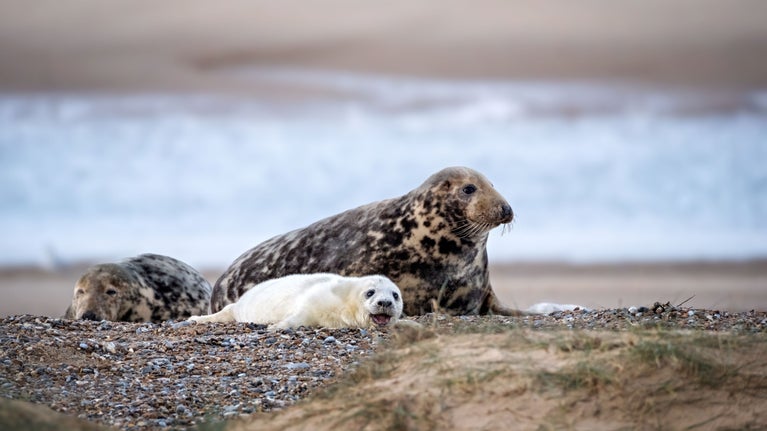National Trust invites nature lovers to tune in for live "pup-dates" from England’s largest grey seal colony
- Published:
- 20 November 2025

Blakeney Point on the Norfolk Coast is once again the stage for one of England’s most extraordinary wildlife spectacles, the annual grey seal pupping season.
Home to the country’s largest colony, over the coming weeks the beach and dunes are set to come alive with thousands of newborn pups over the coming weeks. And, for the first time this winter, audiences everywhere can witness the drama unfold in real time.
A discreet, solar-powered camera has been installed among the dunes, streaming live from inside the colony until early January, when the last pups are expected to be born. Viewers can tune in for regular ‘pup-dates’ at www.nationaltrust.org.uk/blakeney-seal-cam
With the National Trust anticipating another busy year, the livestream offers an unprecedented “seal’s eye view” of life in the colony—capturing tender moments between mothers and pups, playful interactions, fierce fighting between males, and the sheer scale of the spectacle. Crucially it allows nature lovers to experience the pupping season without disturbing the seals, whose success depends on the peace and protection that Blakeney Point provides.
Edward Stubbings, the National Trust’s Area Ranger for Blakeney Point, said: “Last year we trialled the seal camera for the first time and had some great feedback from those who viewed the livestream, as watching the seals can be both fascinating and relaxing.
“Some of the highlights included a live seal birth, cows suckling their pups and bulls vying for dominance and the chance to mate with the females.”
The long-term growth of the Blakeney Point seal colony, and its status as England’s largest grey seal colony, is also now confirmed thanks to the latest data from biologists at the University of St Andrews.
Latest figures published by the Seal Mammal Research Unit (SMRU), part of the School of Biology at the University of St Andrews, estimate that almost 9,000 pups were born at Blakeney Point in 2023.
Pup numbers have increased by more than three-quarters (77%) in just five years from 5,036 in 2018 to 8,946 in 2023.
Over the past decade, pup production has increased more than five-fold from 1,614 in 2013.
With no natural predators, growth at Blakeney Point has outpaced national increases, making it England’s largest grey seal colony
Because of the sheer size of the colony, manual counts are no longer practical or safe. Therefore, since 2014 numbers have been recorded via aerial surveys every two years with SMRU scientists using aircraft and computer modelling with pups classified according to what stage of moulting they have reached, to produce accurate estimates.
Dr Debbie Russell, Deputy Director of the Sea Mammal Research Unit, said: “The UK is of key importance for the grey seal, hosting almost 40% of the species. Following unprecedented increases, Blakeney is now one of the biggest grey seal colonies in the UK; incredibly over 10% of pups born in the UK are born there! SMRU will be conducting aerial surveys of the colony this year to see if this upward trend has continued.”
As well as recording grey seal numbers, the researchers have also been investigating why harbour seal numbers have been declining.
Debbie continued: “The Wash and North Norfolk Coast Special Area of Conservation (SAC), which encompasses Blakeney, was actually designated for the UK’s other seal species, the harbour seal. Unfortunately, in contrast to the grey seal, harbour seal numbers at Blakeney and within the SAC as a whole, have experienced recent declines. SMRU currently have a research programme to try and understand the drivers behind the differing trajectories for the two species in the area.”
Edward concluded: “We’re really proud to look after the largest seal colony in England. The growth in numbers is, in part, down to Blakeney Point offering a vast expanse of gently sloping beach, which makes it an easy place for the seals to haul out.
“The Point’s sand dunes offer the seals and their pups plenty of protection from the elements if the weather turns nasty. And the colony undoubtedly benefits from the Point’s remoteness and the lack of disturbance from people and dogs.
“Blakeney Point is an incredible sight during the pupping season, with seals and pups filling up the beach as far as the eye can see, but the only responsible ways to view this spectacular wildlife event are by taking one of the seal boat trips from Morston Quay or via our live webcam.”
During pupping season, the National Trust and its volunteers maintain a cordon partway along the four-mile shingle spit to prevent disturbance. Dogs are not permitted on the Point. Volunteers also raise awareness about responsible seal viewing and remind visitors of the dangers of approaching mammals that can weigh up to 400 kg and move surprisingly fast if startled.
To find out more and watch the live seal cam visit www.nationaltrust.org.uk/blakeney/seal-cam